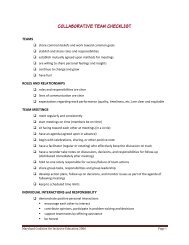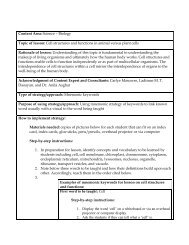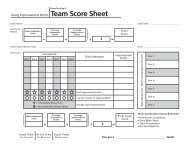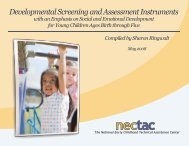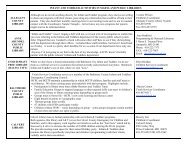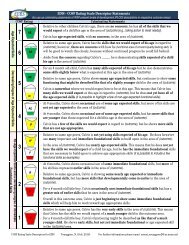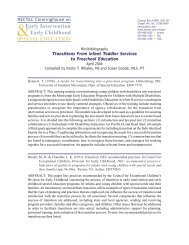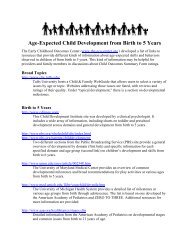The Autism Spectrum Disorder Service Guideline.pdf - CTE - Online ...
The Autism Spectrum Disorder Service Guideline.pdf - CTE - Online ...
The Autism Spectrum Disorder Service Guideline.pdf - CTE - Online ...
Create successful ePaper yourself
Turn your PDF publications into a flip-book with our unique Google optimized e-Paper software.
of the services. This guideline introduces families to the framework for intervention toguide them in this discussion. Families will determine how they will be involved inimplementing their child’s IFSP. Even though the intervention may have a specificcurriculum, the daily activities and routines are individualized step by step andcustomized for each family. However, it is not possible for families to assign the processof “treating” ASD to the Birth to Three staff. Research on child development has shownthat toddlers do almost all of their learning between early intervention visits as theyinteract with their caregivers in a variety of social and physical environments (16) .Principle 3Children with ASD require intensive engagement.By the very nature of the disorder, we know that children with ASD spend little of theirown time engaged in purposeful, appropriate, goal directed behavior. <strong>The</strong>ir tendency isto be either disconnected from their surroundings or fixated on specific aspects of objectsor people. This restricts children with ASD from discovering and learning. Most childrenlearn from interacting with their environment through observation and imitation. <strong>The</strong>seopportunities may be lost to children with ASD.Engagement refers to the amount of time a child is attending to and actively interactingwith others. This happens during the time that the early intervention staff is working witha child. However, most of the engaged time occurs with family members, caretakers,friends, and peers outside of the time when Birth to Three is present. <strong>The</strong> earlyintervention staff works with the family to develop ways to keep a child with ASDengaged. <strong>The</strong> goal of intervention for the child with ASD is to increase the amount oftime he or she is engaged throughout the day in order to achieve the outcomes identifiedon the IFSP. <strong>The</strong> most intensive intervention program is of limited benefit if it does notresult in active engagement in the times when the child is not receiving services.In the past, the Birth to Three System has recommended 15-20 clock hours per week ofBirth to Three services for children with ASD. However, there is no research that we areaware of that has specifically been done with children in this age range that shows thatthis amount of service leads to the best possible outcomes. Existing researchemphasizes the importance of engaged time for the child, not the amount of hours ofservice provided by programs. (17) A poorly structured intervention plan may providemany hours of service that is in a one to one setting with an interventionist but is isolatedfrom the child’s family, peers, and everyday routines. A more effective plan may havefewer interventions, or interventions of shorter duration that allow full participation offamily members, caregivers, and peers. A plan like this will provide opportunities toreflect upon strategies to assure engaged time in multiple settings throughout the courseof the child’s day and week. Research demonstrating the effectiveness of massed trialshas been carried out on children older than three. Research about toddler learning stylesshows that they are not well equipped to generalize learning from massed trials inteaching settings to other settings. (18) This is not to say that the Birth to Three Systemrecommends low intensity plans for children with ASD. Rather, the point is that all tenprinciples articulated in this guideline are considered to be essential to creating andmaintaining good intervention programs for young children with ASD. An emphasis on aparticular number of hours of direct intervention in lieu of assuring a systematic approachemphasizing communication, social engagement, family involvement, positive behavioralsupport, and so on will likely not achieve the optimum outcome. Very young children,recently identified children, or children exhausted by overexposure to a variety ofCT Birth to Three System • <strong>Service</strong> <strong>Guideline</strong> #1 • Revised July, 2002 and January, 200811




